Définition de la réalité augmentée
La réalité augmentée (ou RA) est une technologie qui permet d’intégrer des éléments virtuels en 3D (en temps réel) au sein d’un environnement réel. Le principe est de combiner le virtuel et le réel et donner l’illusion d’une intégration parfaite à l’utilisateur.
La réalité augmentée : plus de 40 ans d’histoire
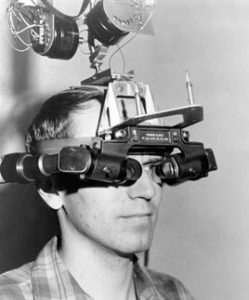
Le premier système de réalité augmentée fut conçu en 1968 par Ivan Sutherland, dans le cadre de recherches au MIT au sein de la prestigieuse université de Boston. Il s’agit à l’époque d’un casque disposant de deux lentilles au niveau des yeux. Celui-ci était relié à l’ordinateur grâce à un bras articulé, d’où le surnom qu’on lui donne à l’époque : épée de Damoclès. L’expérience consiste à afficher un cube en 3D à travers les lentilles. Un ordinateur recalcule l’image et l’angle de vue afin de suivre les mouvements de tête de l’utilisateur. Ce dispositif pose les bases de la réalité augmentée.
Dans les années 80, ce sont les systèmes HUD (Head-up displays ou vision tête-haute) qui sont développés, notamment dans l’armée. Ce système permet d’afficher quelques informations à travers un petit écran transparent, situé dans le champ de vision du pilote/conducteur. On retrouve actuellement ces HUD dans certains véhicules afin d’afficher des informations tels que la vitesse, chemins de destinations ou encore les panneaux rencontrés.
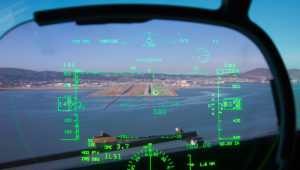
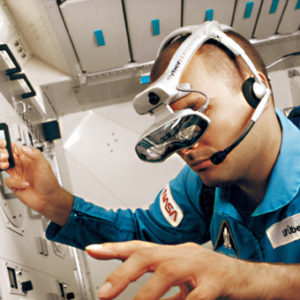
Par la suite, la NASA développe également un casque de réalité augmentée, préfigurant ce que sera le Microsoft Hololens 30 ans plus tard. Léger mais nécessitant de l’informatique embarqué, cet outil permet aux opérateurs d’ajouter une surcouche d’information sur les éléments physique. Plusieurs autres projets similaires verront le jour.
Il faudra attendre les années 90 pour que le terme « réalité augmentée » soit évoqué. En effet, Tom Caudell et David Mizell, deux salariés de chez Boeing, ont développé un outil destiné aux salariés du groupe travaillant sur les chaînes de production. Ce système rajoutait une couche d’informations sur certains éléments de la chaîne, permettant d’avoir un plan technique se fixant sur l’élément physique.
En 1994, Rekimoto et Takashi, deux scientifiques travaillant pour Sony Computer lab., développent NaviCam, le premier système de réalité augmentée capable de lire des marqueurs. Très basique et rapide, Il permettait de lancer des informations textuelles qui venaient se greffer au réel par le biais d’un casque équipé d’un HUD. Les marqueurs deviendront par la suite le support de référence afin de fixer des éléments virtuels dans le réel en offrant un temps de réponse très rapide.
Les marqueurs : première étape de la réalité augmentée mobile.
Les marqueurs sont des repères visuels détectés par l’appareil afin d’effectuer une action. Ils peuvent prendre la forme d’une image ou d’un symbole mais doivent avant tout proposer un contraste important afin d’optimiser la détection. Ils servent de repères afin de fixer un élément en 3D par le biais de la caméra, indispensable au dispositif.
Cependant, les marqueurs sont, à terme, amenés à disparaître, grâce aux avancées technologiques proposées par Apple et Google. Nous développerons cette partie plus loin dans la page.
Les smartphones et tablettes, étape ultime de la RA.
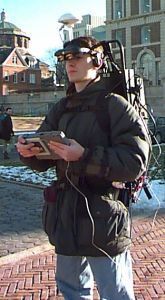
La première version « mobile » de réalité augmentée fut développée à la fin des années 90 et nécessitait un sac à dos connecté à un écran. L’ensemble était lourd, encombrant et limitait drastiquement les capacités de visualisation. Il s’agissait plus d’un projet expérimental qu’un réel outil grand public.
Ceci préfigurait malgré tout de ce que la réalité augmentée mobile allait devenir. L’avènement des téléphones mobiles, et plus particulièrement des smartphones a rendu possible la miniaturisation de ce type de dispositif : appareil photo, écran et informatique embarquée ont permis le développement d’applications réellement mobiles et pertinentes.
La révolution ARKit/ARCore
Cette avancée technologique est issue de deux géants américains que sont Apple et Google, qui ont développé de nouveaux systèmes de réalité augmentée embarqués directement dans le système d’exploitation des smartphones et tablettes. Nommés respectivement Arkit pour Apple et ARcore pour Google, ces systèmes détectent l’espace, la position de l’utilisateur et la lumière ambiante. Cela permet d’afficher et de fixer l’élément en 3D sur les surfaces scannées. Avec la captation de position, il est désormais possible de simuler une pièce virtuelle complète et de se déplacer à l’intérieur à travers son smartphone ou sa tablette. Nous utilisons d’ailleurs ces technologies chez Artefacto pour nos applications en réalité augmentée comme Urbasee.La réalité augmentée : un outil professionnel.
Contrairement à la réalité virtuelle, la réalité augmentée fut majoritairement développée à des fins expérimentales et professionnelles (armée, industrie, etc.). Très vite, les entreprises ont compris les enjeux de cette technologie et ont cherché à se l’approprier. Cependant les barrières technologiques ont longtemps limité son utilisation. Il était nécessaire d’utiliser un ordinateur, un écran et d’autres périphériques encombrants, difficilement utilisables sur le terrain. Avec l’arrivée des smartphones et tablettes, le secteur de la RA est en plein boom et de nombreuses entreprises y trouvent des finalités professionnelles dans leur utilisation. Nous allons les passer en revue.
La réalité augmentée dans l’immobilier
La réalité augmentée dans l’immobilier s’est développée principalement via des outils de visualisation sur tablette. La possibilité de prévisualiser un bâtiment avant construction est une véritable plus-value pour les professionnels car cela renforce la capacité de projection d’un éventuel investisseur et donc, facilite grandement la commercialisation en VEFA. De plus, il est possible d’interagir depuis l’écran sur le modèle 3D projeté. Il s’agit avant tout d’une fonctionnalité, et se retrouve le plus souvent intégrée dans une application proposant d’autres contenus sur le projet. Il existe deux « types » de réalité augmentée répandus dans l’immobilier : sur plan (ou marqueur) et sur site.
La réalité augmentée sur plan
La réalité augmentée sur plan(ou marqueur) consiste à afficher un modèle 3D en visant un plan 2D. Intégrée dans une application dédiée au projet, la réalité augmentée sur marqueur est un des outils phare de la visualisation d’un bien immobilier en 3D. Elle possède également une grande attractivité dans le cadre d’un salon immobilier et propose une interactivité qui permettra par exemple d’enlever les étages, de proposer un accès à des 360°, de télécharger les plans, etc. Il s’agit d’une bonne alternative aux maquettes physiques.
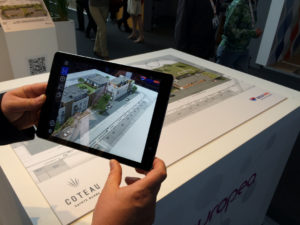
La réalité augmentée sur site
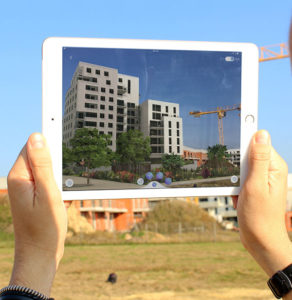
La réalité augmentée sur site offre la possibilité d’afficher un modèle 3D directement sur le lieu de construction à l’échelle 1:1. Il permet une excellente immersion et décuple la capacité de projection des investisseurs en les mettant face au projet dans la réalité et donne un bon aperçu de l’intégration de l’architecture. Il nécessite cependant de se rendre sur le lieu de construction afin de « tracker » le réel et de fixer le projet final en 3D. Il s’agit donc d’un très bon complément de la réalité sur marqueur. Dans le cas d’un constructeur de maisons individuelles, cette technologie peut lui permettre de constituer un véritable catalogue de maisons en 3D qu’il peut projeter sur le terrain de ses clients.
La réalité augmentée dans l’industrie
Dans l’industrie, la réalité augmentée devient un excellent moyen de promouvoir un projet : usine, chaîne de production, produits.
Celle-ci répond à une problématique bien connue des industriels : montrer ce qui est difficile, voire impossible de déplacer comme les chaînes de production ou les machines agricoles lors des salons, par exemple. Intégré dans une application mobile, il est possible de faire une démonstration de son fonctionnement de manière très fidèle. Les flux ou les parties mobiles sont animées (bras articulés, engrenages, personnages, etc.) et permettent d’aisément comprendre le fonctionnement d’une machine ou d’un objet présenté. On peut également y ajouter des parties interactives, permettant d’accéder à des éléments supplémentaires de compréhension : fiches informatives, éléments zoomés, vidéos.
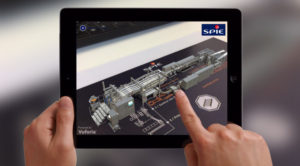
Les catalogues augmentés : outil de vente ultime ?
Existent également les applications catalogues, permettant de montrer des produits en réalité augmentée. Nouvel outil du commercial, ou disponible en libre téléchargement, ce type d’application permet d’intégrer un produit en 3D à taille réelle, et ce, n’importe où. Combiné à un système d’achat intégré, il est, par exemple, possible d’essayer un canapé, ou une armoire chez soi afin de voir s’il convient, et de l’acheter directement depuis l’application. Une petite révolution pour le e-commerce avec cet essayage dématérialisé ! Artefacto a d’ailleurs choisi d’emprunter cette voie pour commercialiser son outil Urbasee, que vous pouvez essayer gratuitement.
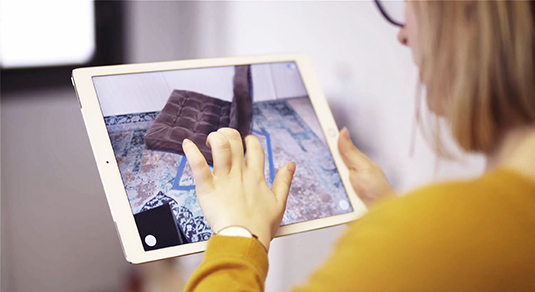
La RA dans les musées
La réalité augmentée dans les musées n’est également pas en reste et plusieurs finalités existent. Elle peut être utilisée afin de projeter en 3D des objets disparus, inaccessibles, dans le cadre de reconstitutions du passé. Elle s’intègre également parfaitement dans des applications ludiques avec l’affichage d’éléments en réalité augmentée comme des personnages ou points d’intérêts qui viendront enrichir la visite et donneront l’occasion aux visiteurs de se focaliser sur des éléments d’architecture, par exemple. L’objectif pour les musées est donc de proposer des visites améliorées, augmentées, en proposant un contenu enrichi. La réalité augmentée sert également d’outil pédagogique pour les enfants, afin de manipuler, jouer dans un contexte culturel et leur donner d’autres clés de compréhension. Intégrée dans un jeu ludique, ils en ressortiront heureux et surtout rempli de connaissances !
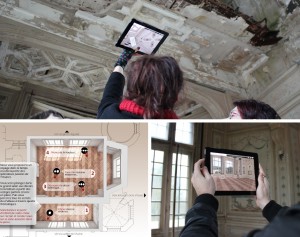
Un avenir radieux pour la réalité augmentée
Une notoriété accrue pour la réalité augmentée
La réalité augmentée a connu en 2016 un bouleversement majeur. En effet, suite à l’énorme succès du jeu pour smartphone Pokémon Go ! (application la plus téléchargée de tous les temps), la notoriété de cette technologie s’est drastiquement amplifiée donnant l’opportunité de se faire connaître au plus grand nombre. La réalité augmentée est maintenant facilement comprise par le grand public.
On peut également citer Snapchat, qui depuis maintenant quelques années, a intégré des filtres (lenses) en réalité augmentée. Sans réellement le savoir, le grand public utilise déjà cette technologie !